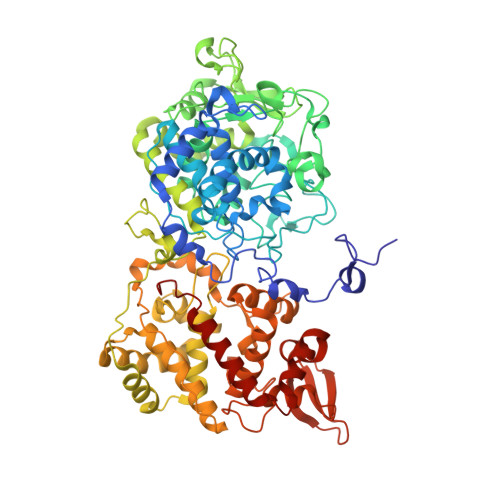The crystal structure of isoniazid-bound KatG catalase-peroxidase from Synechococcus elongatus PCC7942.
Kamachi, S., Hirabayashi, K., Tamoi, M., Shigeoka, S., Tada, T., Wada, K.(2015) FEBS J 282: 54-64
- PubMed: 25303560
- DOI: https://doi.org/10.1111/febs.13102
- Primary Citation of Related Structures:
3WXO - PubMed Abstract:
Isoniazid (INH) is one of the most effective antibiotics against tuberculosis. INH is a prodrug that is activated by KatG. Although extensive studies have been performed in order to understand the mechanism of KatG, even the binding site of INH in KatG remains controversial. In this study, we determined the crystal structure of KatG from Synechococcus elongatus PCC7942 (SeKatG) in a complex with INH at 2.12-Å resolution. Three INH molecules were bound to the molecular surface. One INH molecule was bound at the entrance to the ε-edge side of heme (designated site 1), another was bound at the entrance to the γ-edge side of heme (site 2), and another was bound to the loop structures in front of the heme propionate side chain (site 3). All of the interactions between KatG and the bound INH seemed to be weak, being mediated mainly by van der Waals contacts. Structural comparisons revealed that the identity and configuration of the residues in site 1 were very similar among SeKatG, Burkholderia pseudomallei KatG, and Mycobacterium tuberculosis KatG. In contrast, sites 2 and 3 were structurally diverse among the three proteins. Thus, site 1 is probably the common KatG INH-binding site. A static enzymatic analysis and thermal shift assay suggested that the INH-activating reaction does not proceed in site 1, but rather that this site may function as an initial trapping site for the INH molecule. Database: The atomic coordinates and structure factors have been deposited in the Protein Data Bank under the accession number 3WXO.
Organizational Affiliation:
Graduate School of Science, Osaka Prefecture University, Sakai, Osaka, Japan.

















